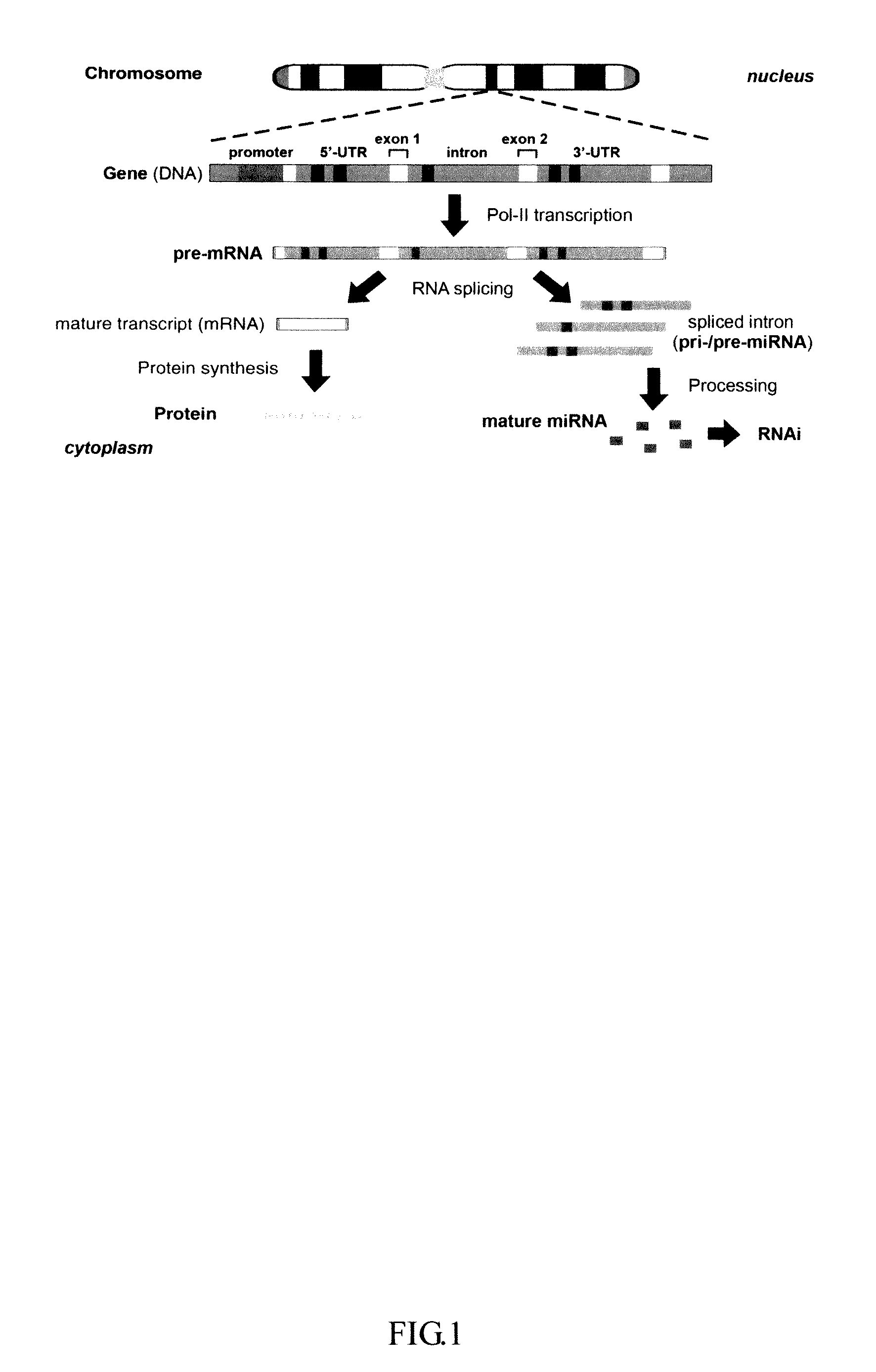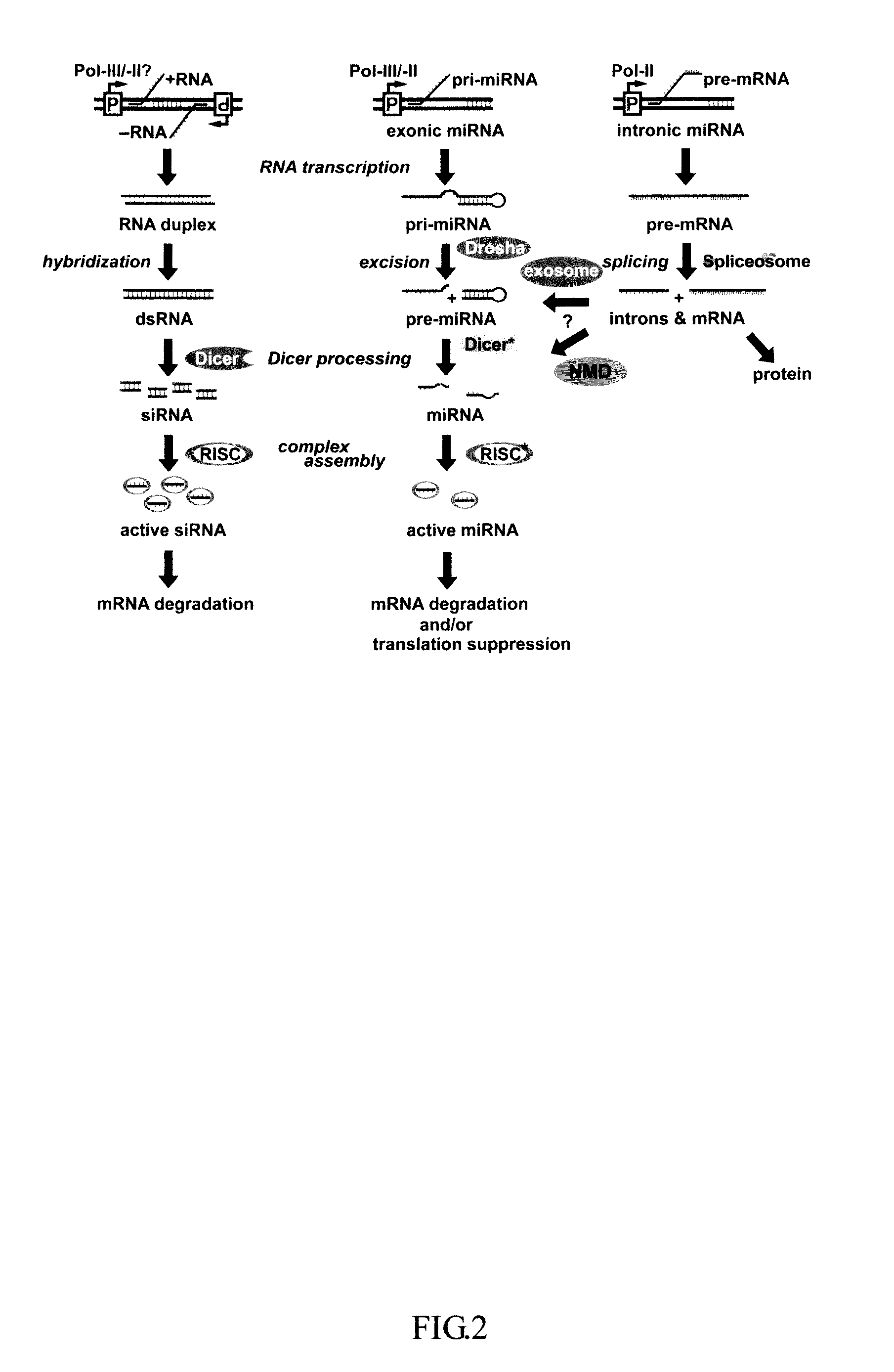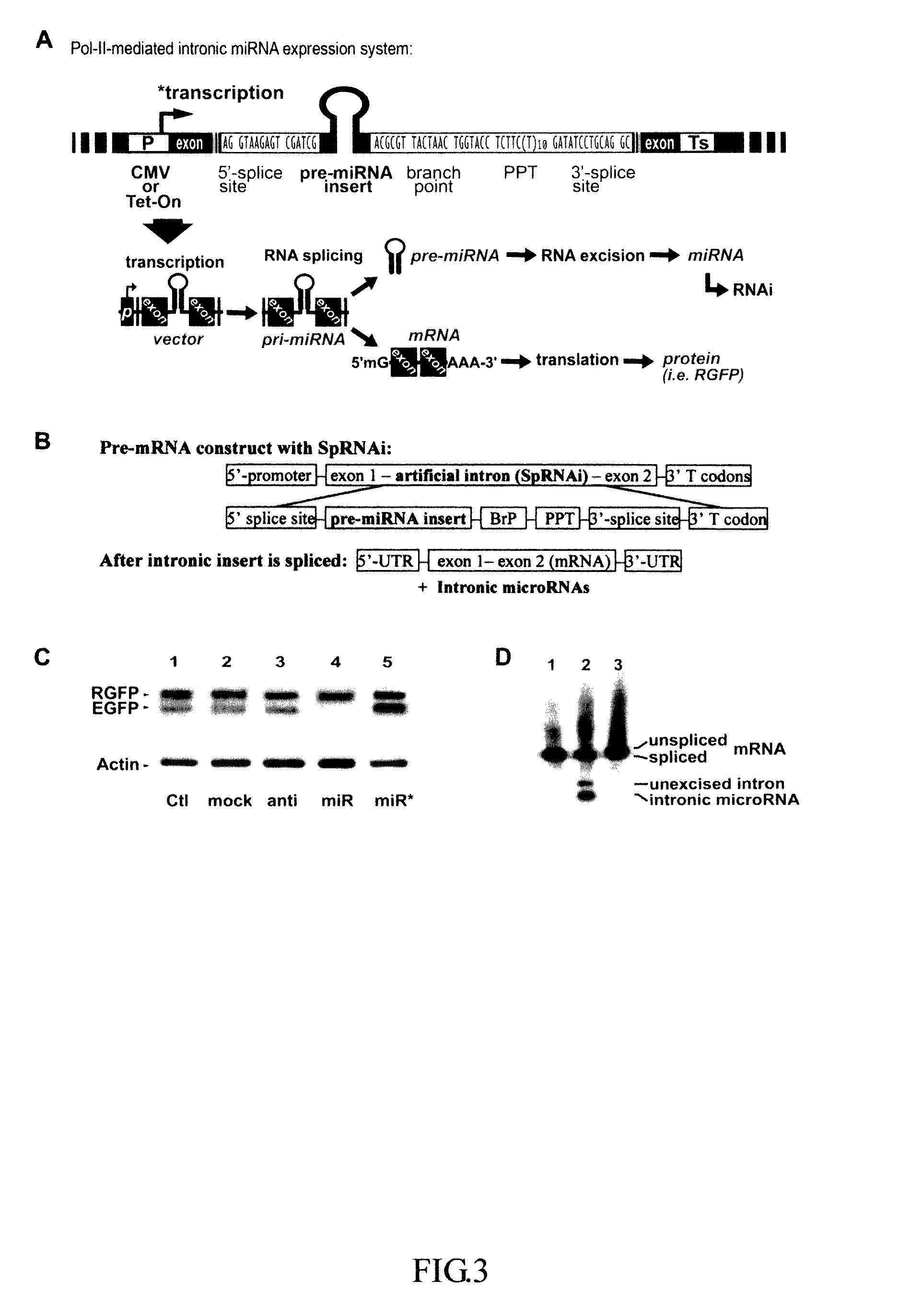Generation of human embryonic stem-like cells using intronic RNA
a technology intronic rna, which is applied in the field of human embryonic stem cells generation using intronic rna, can solve the problems of difficult control of purity and quality, limited sources for cloning human stem cells, and immune rejection in patients, so as to improve the stability of delivery and control the transcription rate of gene silencing effectors, and the effect of stable and relatively long-term effect of specific gene silencing
- Summary
- Abstract
- Description
- Claims
- Application Information
AI Technical Summary
Benefits of technology
Problems solved by technology
Method used
Image
Examples
example 1
Construction of SpRNAi-Containing Recombinant Gene (SpRNAi-RGFP)
[0121]Synthetic nucleic acid sequences used for generation of three different SpRNAi introns containing either sense-, antisense- or hairpin-EGFP insert were listed as follows: N1-sense, 5′-GTAAGAGGAT CCGATCGCAG GAGCGCACCA TCTTCTTCAA GA-3′ (SEQ. ID. NO. 14); N1-antisense, 5′-CGCGTCTTGA AGAAGATGGT GCGCTCCTGC GATCGGATCC TCTTAC-3′ (SEQ. ID. NO. 15); N2-sense, 5′-GTAAGAGGAT CCGATCGCTT GAAGAAGATG GTGCGCTCCT GA-3′ (SEQ. ID. NO. 16); N2-antisense, 5′-CGCGTCAGGA GCGCACCATC TTCTTCAAGC GATCGGATCC TCTTAC-3′ (SEQ. ID. NO. 17); N3-sense, 5′-GTAAGAGGAT CCGATCGCAG GAGCGCACCA TCTTCTTCAA GTTAACTTGA AGAAGATGGT GCGCTCCTGA-3′ (SEQ. ID. NO. 18); N3-antisense, 5′-CGCGTCAGGA GCGCACCATC TTCTTCAAGT TAACTTGAAG AAGATGGTGC GCTCCTGCGA TCGGATCCTC TTAC-3′ (SEQ. ID. NO. 19); N4-sense, 5′-CGCGTTACTA ACTGGTACCT CTTCTTTTTT TTTTTGATAT CCTGCAG-3′ (SEQ. ID. NO. 20); N4-antisense, 5′-GTCCTGCAGG ATATCAAAAA AAAAAGAAGA GGTACCAGTT AGTAA-3′ (SEQ. ID. NO. 21). All...
example 2
Cloning of SpRNAi-Containing Genes into A Expression-Competent Vector
[0125]Because the recombinant SpRNAi-RGFP gene possessed an XhoI and an XbaI restriction site at its 5′- and 3′-end, respectively, it can be easily cloned into a vector with relatively cohesive ends to the XhoI and XbaI restriction sites. We mixed the SpRNAi-RGFP gene with the linearized 3,934-bp empty pHcRed1-N1 / 1 plasmid at 1:16 (w / w) ratio, cooled the mixture from 65° C. to 15° C. over a period of 50 min, and then added T4 ligase and relative buffer accordingly into the mixture for ligation at 12° C. for 12 hr. This formed an SpRNAi-RGFP expression vector, which can be propagated in an E. coli DH5α LB culture containing 50 μg / ml kanamycin (Sigma Chemical, St. Louis, Mo.). A positive clone was confirmed by PCR with the RGFP-specific primers SEQ. ID. NO. 23 and SEQ. ID. NO. 24 at 94° C., 1 min and then 68° C., 2 min for 30 cycles, and for further sequencing. For cloning into viral vectors, the same ligation proced...
example 3
In Vitro Transgenic Transfection
[0129]For retroviral vector transfection into the hpESC and PC3 cell cultures, we first cultured the SpRNAi-RGFP-expressing pLNCX2 retroviral vectors containing either an anti-EGFP mir-gfp or a mir-302 familial cluster pre-miRNA insert in the pVSV-G co-transfected GP2-293 cells (Clontech, CA). After 36-hour incubation at 37° C. under 5% CO2, the cultural mediums (10 ml each) of the GP2-293 cells were filtrated (0.25 μm) and directly transferred into the hpESC and PC3 cell cultures, respectively. Since the mediums contained very high titers of the designed retroviral vectors, all the tested cells were transgenically infected by the vectors and started to express the intronic inserts and RGFP within 24 hours. For transgenic delivery of the manually re-designed mir-302 pre-miRNA into Colo cells, we first mixed the prepared SpRNAi-RGFP transgene (60 μg for 10 ml medium in each cell culture) containing the designed mir-302 pre-miRNA insert from Example 2 w...
PUM
| Property | Measurement | Unit |
|---|---|---|
| pH | aaaaa | aaaaa |
| pH | aaaaa | aaaaa |
| concentration | aaaaa | aaaaa |
Abstract
Description
Claims
Application Information
 Login to View More
Login to View More - R&D
- Intellectual Property
- Life Sciences
- Materials
- Tech Scout
- Unparalleled Data Quality
- Higher Quality Content
- 60% Fewer Hallucinations
Browse by: Latest US Patents, China's latest patents, Technical Efficacy Thesaurus, Application Domain, Technology Topic, Popular Technical Reports.
© 2025 PatSnap. All rights reserved.Legal|Privacy policy|Modern Slavery Act Transparency Statement|Sitemap|About US| Contact US: help@patsnap.com



